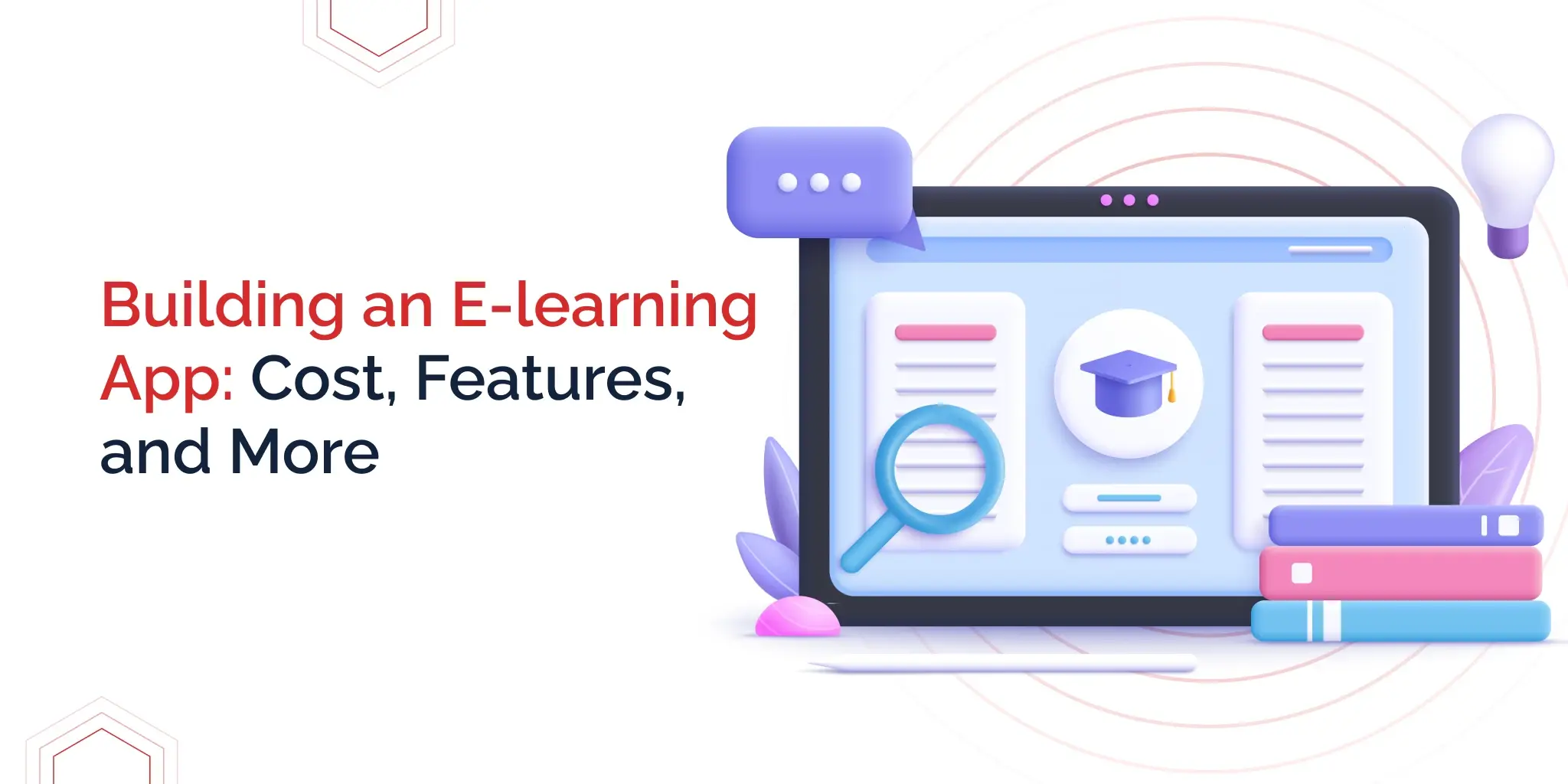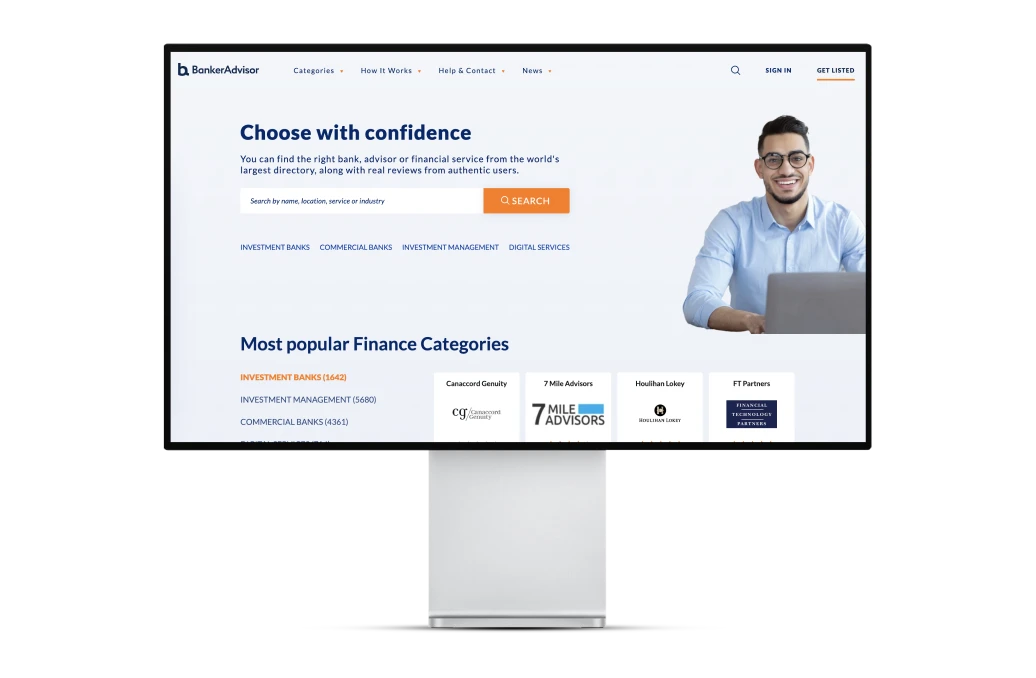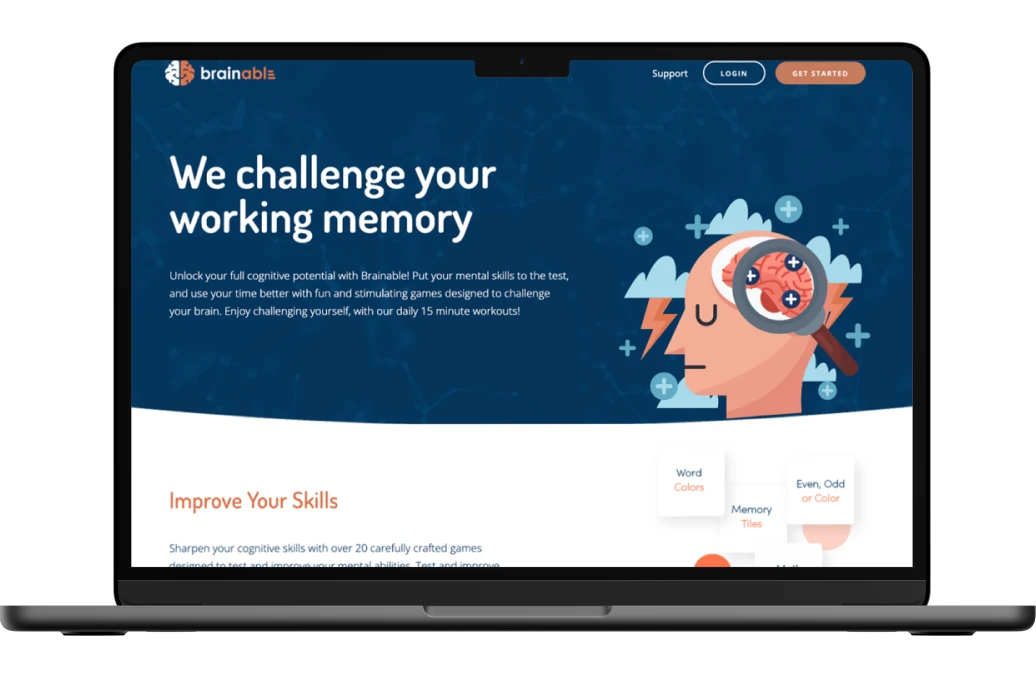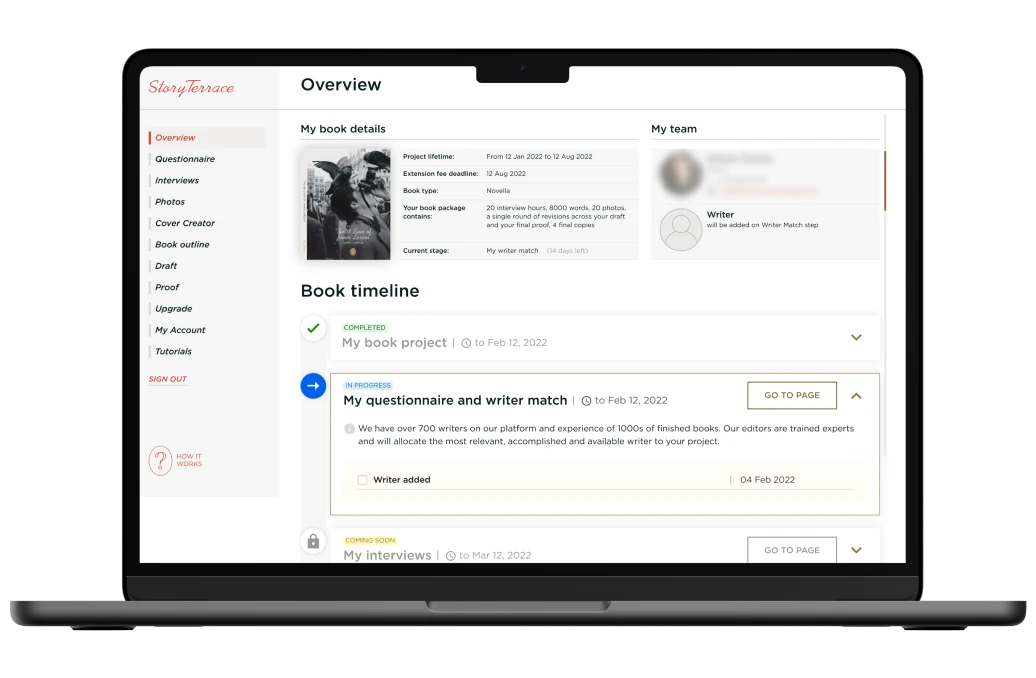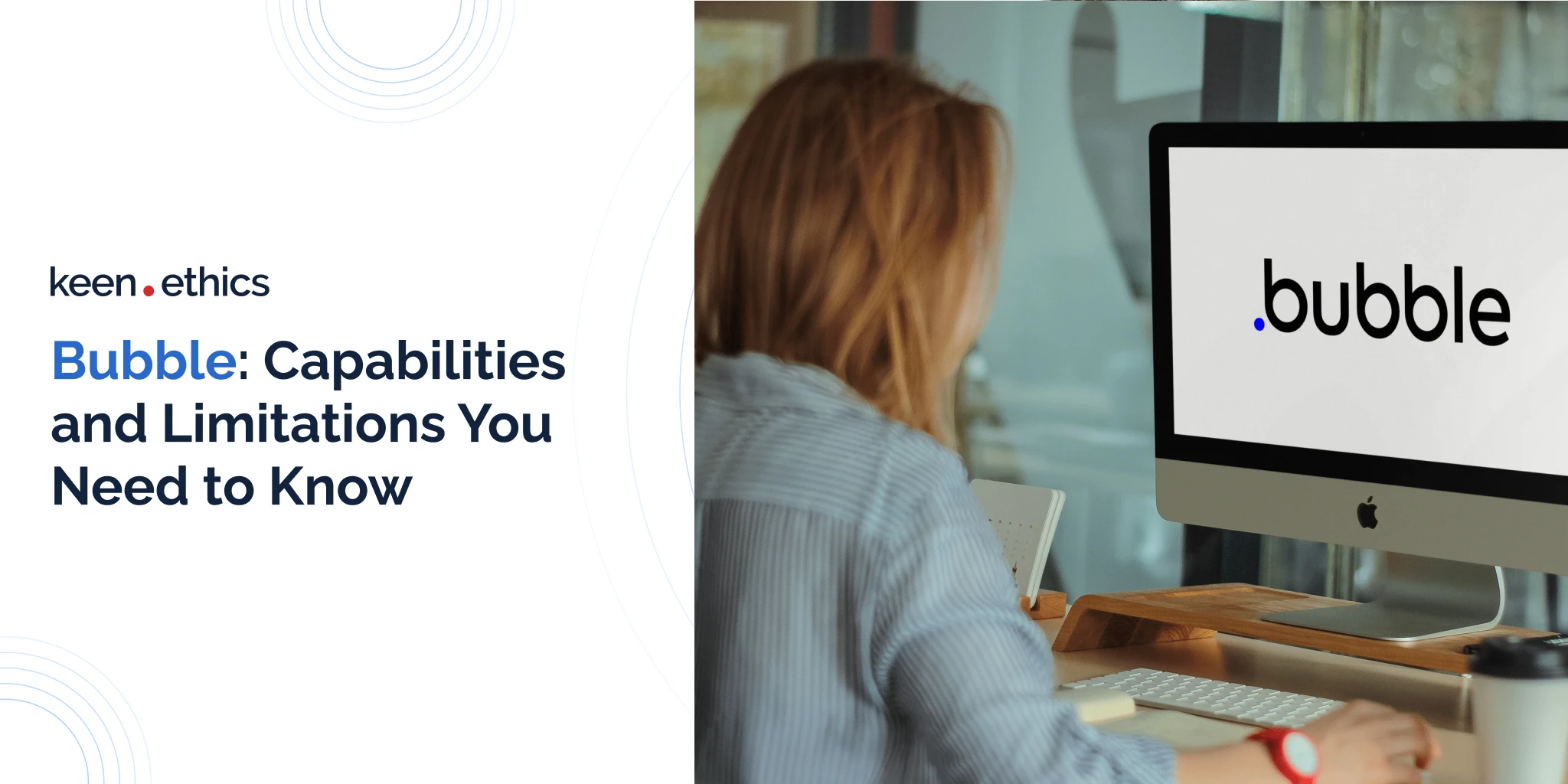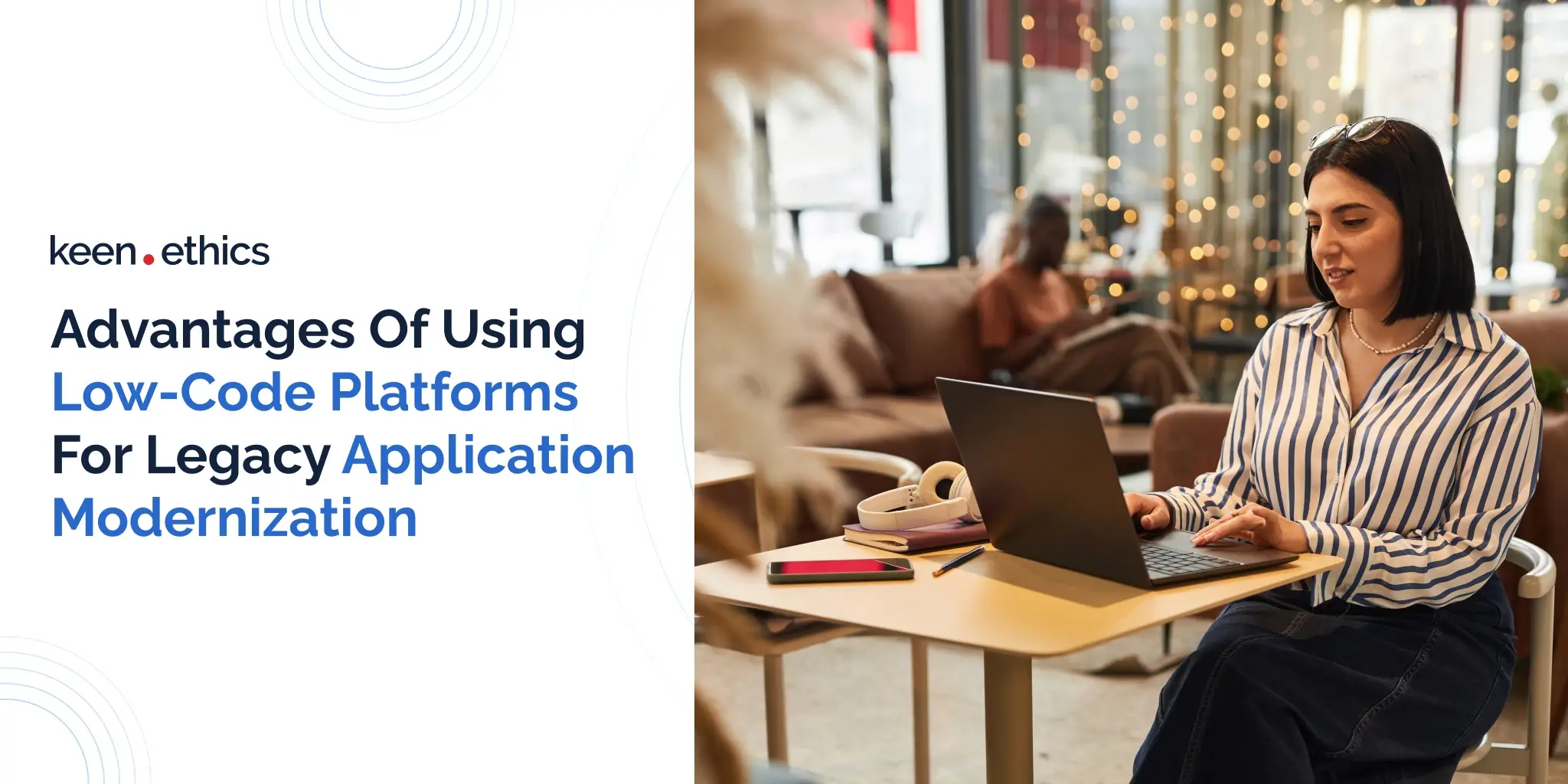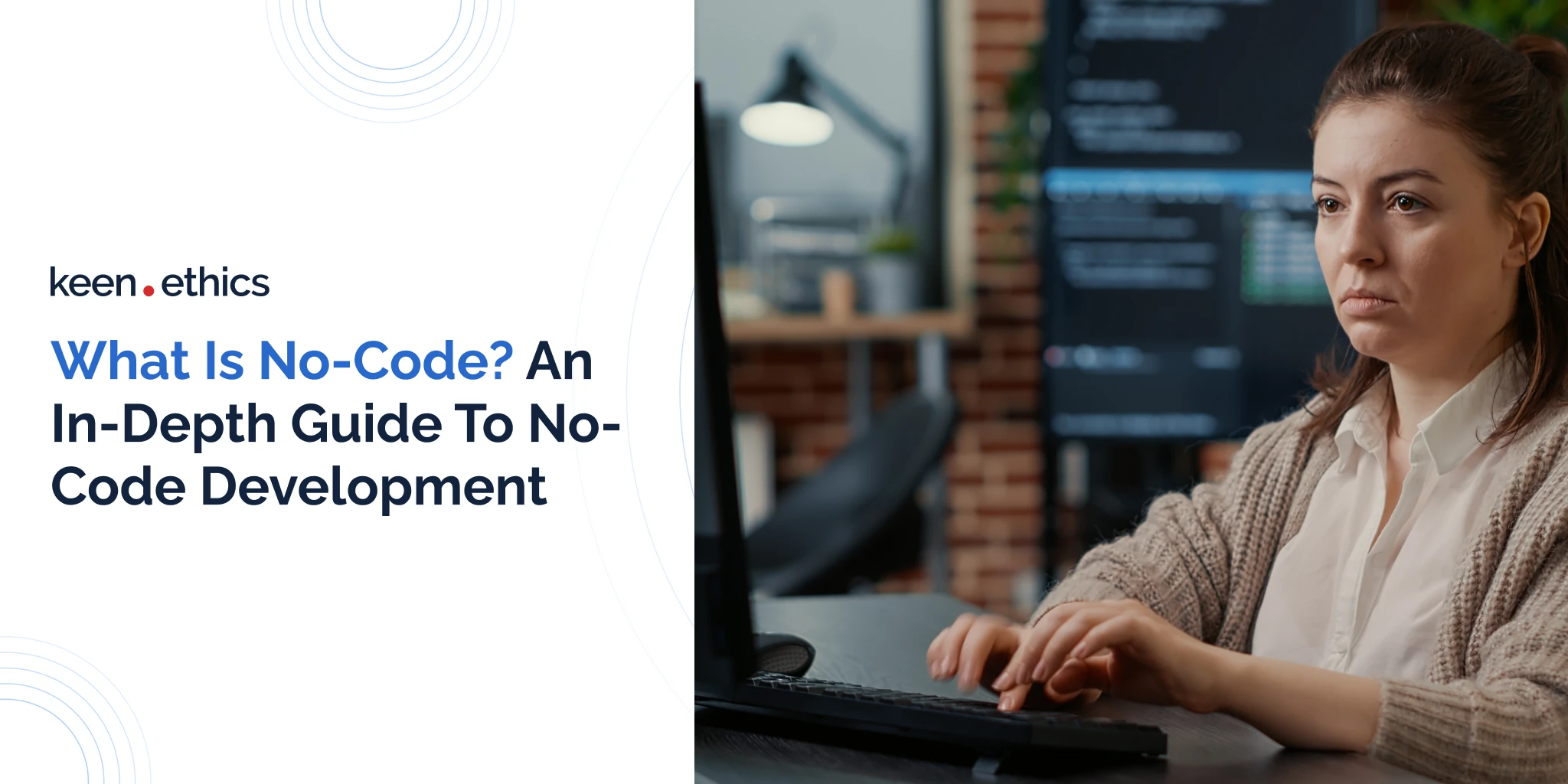Are you interested in creating an e-learning solution? Let’s find out how to engage in educational app development.
E-learning is now at the forefront of education technologies due to enhancing students’ learning capacities. Common questions about innovation touch upon cost, features, and development. This article looks at the key aspects of building an e-learning app: the whole process is easy to implement if you have a clear framework.
Understanding eLearning Apps Better
E-learning is a complex field that is at the forefront of education technologies. Generally, we can highlight five types of e-learning apps:
- Learning Management Systems (LMS): these are platforms that allow educators to manage online courses. Common examples of these platforms include platforms like Moodle or Canvas.
- Language Learning Apps: many people want to learn languages for tourism or work. Apps like Duolingo help them with those goals by using interactive lessons and gamified approaches.
- Skill Development Platforms: the core aspect that separates a strong professional from an average one is skill development. Websites and apps like Udemy and Coursera help with acquiring those skills through a wide variety of courses.
- Flashcards and Study Aid Apps: memorization is among the core approaches to learning. Even with the most efficient learning strategies, you may still have to memorize 30 to 40% of the information. Tools like Anki assist with this goal through flashcards and quizzes.
- Virtual Classroom Apps: distance learning is growing in popularity these days. Platforms like Zoom help with organizing online classes. These classes allow educators and students to study and teach from any location in real-time.
Common questions about innovation touch upon cost, features, and development. This article looks at the key aspects of building an e-learning app: the whole process is easy to implement if you have a clear framework.
Overview of the E-Learning App Market in 2023-2025
The market is growing yearly, with more and more people learning how to create an e-learning app. Current research indicates its size is between 50 and 100 billion dollars (depending on the methodology). Moreover, by 2030, the e-learning app market will grow to 645 billion dollars, showing tremendous potential for expansion. This means any investment into e-learning makes sense: an increasing number of people are buying learning products. E-learning apps teach languages, mathematics, and even programming through diverse methodologies. Some e-learning apps deliver traditional guides; others provide micro-learning sessions (for instance, Duolingo). More importantly, many interesting ideas are still waiting for implementation. E-learning is in its infancy, so you should pay attention to it.
Benefits of e-Learning Application Development
Elearning apps offer a wide set of benefits to their users. Here’s a list of the top five benefits you should consider:
- Accessibility and flexibility: a typical elearning platform helps learners access educational content at any time and in any place. In this way, it becomes easier for them to fit learning sessions into their schedules. This flexibility of an average elearning application is crucial for promoting a diversity of styles in learning.
- Cost-effectiveness: e-learning software development is essential if you want to reduce costs that characterize traditional education. Elearning app development results in cost savings for aspects like travel and learning materials. For instance, you can build an e-learning app for mathematics learning with strong support for 3D. In this way, you’ll be able to save costs on real props for mathematical explanations.
- Scalability: a major reason to build an e-learning platform is the ability of this technology to work with a large number of users. If your course grows in popularity, it’s easy to make it accessible to large audiences with the help of elearning apps. In this regard, the same content can be easily distributed to both small and large audiences without major losses in terms of content.
- Personalized learning experience: modern mobile elearning apps can incorporate learning technologies that adapt content to the unique needs of the users. A language learning app using this approach can have an algorithm that focuses on user interests incorporated during the development process. This approach is vital for ensuring maximum engagement among the students.
- Data tracking and analytics: elearning industry opens a path for high-quality analytics aimed at teachers and learners. Various types of elearning apps can track user progress and give educational institutions insights on the ways to improve it. Knowing this data, educational institutions can assess whether their programs are effective and offer personalized learning experiences.
Who Needs Custom E-Learning App Development?
Custom e-learning application development is crucial for multiple types of organizations:
1) Educational institutions: schools and universities can benefit from online learning app development by enhancing their curricula through online courses or blended learning. Personalization is also among the positives this technology offers.
2) Business training departments: in many cases, an elearning mobile app can help with optimizing the training process. For instance, certain types of elearning platforms may be essential for small-session learning that will help combine work with training.
3) Training organizations: many training organizations need an app development partner to provide high-quality services for their customers. The presence of an app is often seen as a requirement for the majority of training programs.
4) Government agencies: employee training is also necessary for government agencies. They often have complex procedures that require active learning. Developing elearning apps is, therefore, a necessity because it allows one to promote efficient training practices.
5) Healthcare organizations: healthcare providers need to constantly train their workforces in order to succeed. In this light, an investment in a custom elearning application is a must. In this regard, a succesful elearning app is essential if you want to simplify the process of learning new information for your employees.
Why Do Businesses Choose to Outsource eLearning App Development?
This guide to e-learning app development focuses primarily on outsourcing. Why is this the case? Many organizations interested in elearning software don’t have dedicated development teams. Hence, it makes sense to invest in e-learning through an outsourcing company. These companies have advanced knowledge of e-learning software development and possess pre-made teams. This approach allows businesses to save money on team creation and enjoy advanced expertise from real industry professionals.
How to Create a Successful E-Learning App Idea?
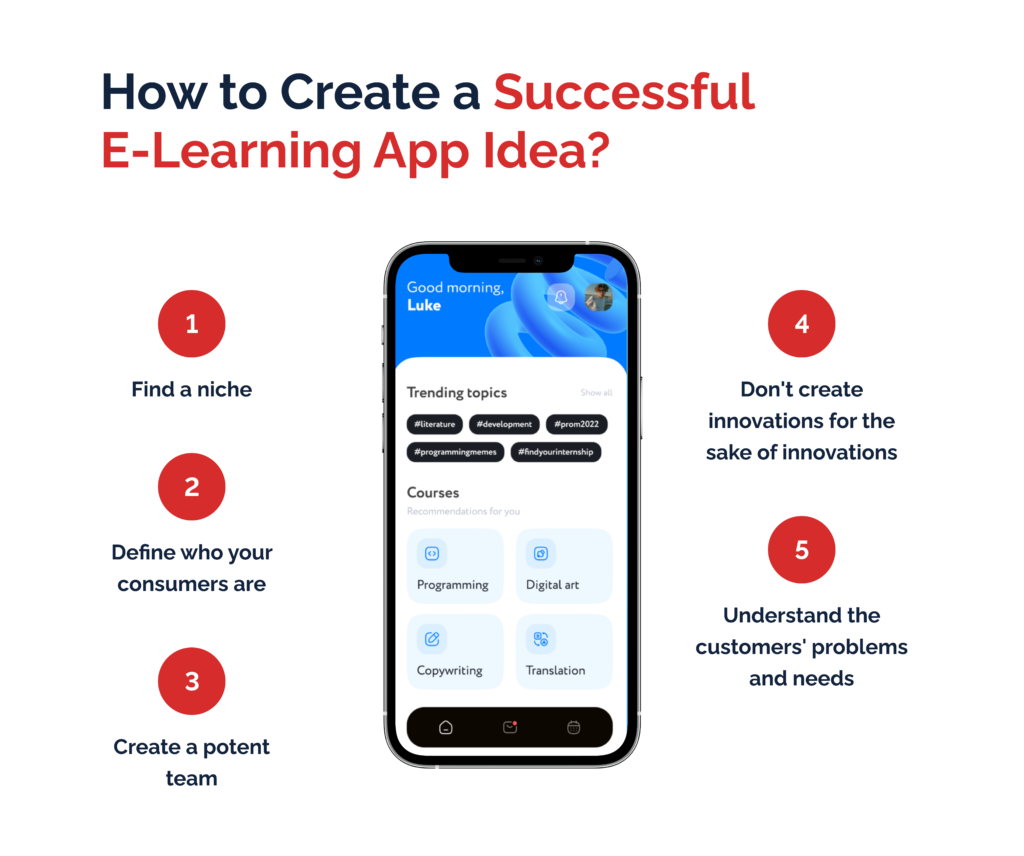
How to create an e-learning app? Let’s look at the key steps:
Find a niche
Many e-learning apps are already on the market, offering obvious solutions to studying problems. If you deliver a learning approach available in other apps, failure is probable. It’s crucial to focus on the ideas without interesting implementations. Another vital aspect is finding a sector outside the market leaders’ attention. In short, one needs some niche where their business doesn’t encounter much resistance. Remember the Blue Ocean strategy: consider the sector where a new or refined old idea works best.
Define who your consumers are
Every advanced business has a clear understanding of the target audience. You must imagine the person who wants to use your service. Give a name to the persona, describe their age, profession, and interests, and think about how they use the app. This approach allows seeing which features are important for your app. For example, an individual who works 9-to-5 and wants to learn English may benefit from microlearning sessions. University students have more time for learning, so you can offer them longer lessons. Even the most niche ideas feature several implementations: by defining the audience, businesses save time in finding the best one.
Create a potent team
When experts discuss how to develop an e-learning app, they often concentrate on software but forget the organizational aspect. Once you clearly understand your app, it’s crucial to find people who will implement the vision. Having a great idea is good, but great experts should be behind it, too. Firstly, search for experienced developers who can deliver an app without major bugs. Secondly, create a good marketing team: firms should select people who know how to work with the target audience. If any factor fails, the app may function poorly, or the key users won’t discover your software.
Don’t create innovations for the sake of innovations
A common mistake for many developers is to innovate for innovation’s sake. What do we mean by that? Some experts add features to distinguish themselves from the competition. They include obscure word-learning methods or even AI. The problem with this attitude is the inefficiency of some approaches. Users aren’t always after originality; they want a structured experience. Language learning has clear rules: one should learn vocabulary, grammar, speaking, and writing. A niche is often about solving problems with one of the aspects of e-learning. If you provide AI to test users’ texts in an app combining grammar and vocabulary learning, it’s possible to start a revolution. Duolingo, an app for studying languages, is popular because it focuses on several aspects. Instead of concentrating on vocabulary, it presents grammar, word learning, and writing. There’s nothing new, but the experience is comprehensive.
Understand the customers’ problems and needs
Customer pains and desires are different, and you should target both. Let’s review an example of this framework via language learning apps. The average customer’s pain for language learning is the lack of time. So, the idea is to let the individuals study through minor sessions. Simultaneously, the customer desires to be good at languages (French or Spanish, for instance). This means firms must use scientifically proven methods of learning to facilitate progress. Using the pain/desire dichotomy, one can quickly create goals for their project.
E-Learning App Features
How to build an e-learning mobile app? Let’s look at the key features one should have!
Systems for Managing Content
E-learning apps prioritize content management systems with advanced features for seamless organization and distribution of educational materials. These systems, optimized for mobile devices, ensure a user-friendly learning journey. Real-time updates and interactive discussion forums enhance the online learning experience, fostering collaboration among users in an online learning app. E-learning app development is one of the most promising fields for investment these days due to these transformative effects.
Game-like Elements
Integration of game-like elements during e-learning app development adds a dynamic dimension to mobile learning apps, increasing engagement for the essential features. This approach, supported by a cutting-edge tech stack, transforms learning into an interactive and enjoyable experience. As mobile applications continue to evolve, these features redefine the landscape of e-learning. For instance, more and more companies are adding virtual reality game-like elements.
Offer Personal Accounts
Learning customization is an essential element of any good app. Give personal profiles to the learners and teachers so that they select their experience. Accounts should provide different options for the users: depending on the scope, they may include visual customization and even difficulty settings.
Structured Courses
All good learning involves a clear structure: you should start from simple concepts that transition into something complex. When creating an e-learning application, always consider a course-like approach. Duolingo, for instance, starts with easy language concepts and then transitions toward complex topics. Brainable offers a similar framework of step-by-step learning. The idea is to guide the students instead of leaving them to figure out everything independently.
Testing systems
Feedback regarding different tasks has always been an essential part of learning. By getting scores, the students see their errors and determine where they should double their efforts. An automatic testing system helps learners understand their strengths and weaknesses.
Communication Tools
E-learning has an important advantage: it allows studying via smartphones and computers. Since they’re easy to use from home, this approach gives a perfect option for distance learning. If you want the users to like an app, deliver chats and video conferences as they enable one to participate in lectures from any country.
Certificates
After finishing an e-learning course, students want proof of their skills. Certificates are the best way to celebrate achievements as they allow the customers to showcase progress to employers, for example. So, try to create e-learning apps offering legitimate knowledge for some high-quality certificate.
Evaluation system
Certificates often showcase not only the course completion but also the students’ scores. This is necessary to prove that the client put in an effort instead of quickly going through some lectures. Evaluation is also a perfect way to understand if a learner should study further.
Reminders for the users
Our observations show the best learning is always continuous. What do we mean by that? A student has to learn periodically: for example, it’s a good idea to study some English words every day. Repetition improves your memory and pushes toward quick learning. The problem with this method is that students are sometimes too overworked or lazy. A reminder saves the learning streak for an individual and pushes them toward a more responsible approach. This method is strong for microlearning sessions: a small daily notification becomes a habit.
Systems for homework analysis
No learning occurs in the classroom alone: the students must show their efforts personally. The best way to force progress is a homework system. Let’s imagine such a framework: you can give some practical readings on a dedicated page and then provide a students’ knowledge test. In this way, the homework system will be both customizable and automatic.
Payment
All good e-learning apps have monetization (even free and open-source software asks for voluntary donations). If your app has paywalled premium features or uses a one-purchase model, it’s essential to offer comfortable payment. Give the most used services, such as credit cards and Google/Apple systems. The faster a customer buys something, the better it’s for him/her and you. Many people avoid service if payment is difficult (for instance, via Bitcoin). Our company offers apps with payment models that work well.
How to Create an E-Learning App: Step-by-Step Guide
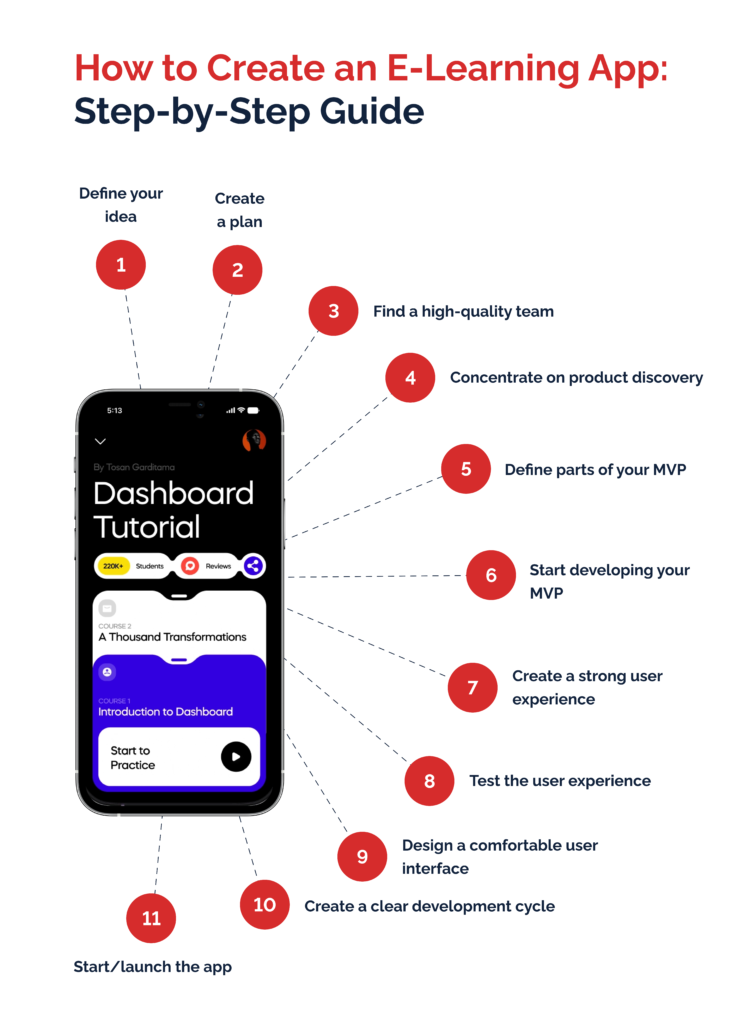
Creating an e-learning app isn’t difficult if one follows these steps. You can build an e-learning app even without expertise by hiring a team of outsourced developers:
1. Define your idea
The first step to consider is creating your framework for the software. What is your niche? Who is the target audience? What does your app do differently? Define the key ways in which the app is unique.
2. Create a plan
Once you have a clear idea, it’s time to make it precise. Create technical requirements for the app (features and technology) and then transition to the business plan to understand your monetization and promotion models.
3. Find a high-quality team
To develop and sell an e-learning app, you must have strong coders and marketing specialists. Two ways exist to assemble a team: one may create it personally or hire an outsourcing company to work on their ideas. For people with programming experience, the first option is better. As for business-oriented individuals, outsourcing is superior.
4. Concentrate on product discovery
Discuss your project with a team before coding to understand the product. Show the key technical requirements and create conceptual representations of your app. You should know what an interface will look like. Sometimes, ideas seem great on paper but don’t go through the basic sanity check.
5. Define parts of your MVP
The minimum viable product is an app version usable enough to present the key features. It saves money for development by minimizing resources for a marketable project. Before coding, try to understand what is crucial for your product. Not everything is as important as it seems: sometimes, functions are better than the user interface.
6. Start developing your MVP
Don’t hesitate to start coding as soon as possible. The earlier you begin development, the better because an MVP for a failing project saves some time. Besides, early MVP development is essential since it helps refine some ideas. As mentioned before, not everything that seems to be great on paper is good in reality.
7. Create a strong user experience
MVP should deliver the basic user experience for the key customers. If you’re developing a language course app, all its key features must appear as soon as possible. The user should be able to learn a language via your MVP with moderate comfort.
8. Test the user experience
Once you have an MVP offering a streamlined user experience, test it. Let real clients define what they like or don’t like in the app. A good option is to release the product to some app store (either Google’s or Apple’s). Firms call such application versions alphas or betas and give some bonuses for early testing. The key idea is to understand what approaches work and see who your customers are. A language learning app can target children but find success among adults, so only real-life tests show the value of your solution.
9. Design a comfortable user interface
If the customers find your app interesting, it’s time to refine it. Add some additional features for greater comfort. The key aspect to concentrate on is the user interface: the idea is to make everything as intuitive as possible. An MVP may have some primitive interfaces and offer a crude experience. The final product should refine every software aspect.
We have a potent example of this in the real world: Duolingo has been in development for almost 12 years. Its free-to-use MVP had attracted thousands of learners despite featuring a primitive and clunky interface at first. After gradual development, the app now has a comfortable interface prioritizing the important features and image-based graphics. A similar transformation must occur for your MVP. It should turn into a full-scale marketable product from something clunky but functioning.
10. Create a clear development cycle
Successful MVP and UI feedback mean you can deliver a plan for future app development. Choose what features to add and the longevity of support for the software. This approach attracts users by telling them you won’t abandon the MVP idea and refine it.
11. Start/launch the app
Have you completed all the steps? Then, don’t hesitate to begin a full-scale launch; be careful with bugs, however. The release version should feature no major problems to gain success.
Problems That May Appear During the Creation of an E-Learning App
Budget Limitations
One of the challenges in e-learning mobile app development is budget limitations. The creation of a comprehensive educational platform requires financial resources for skilled mobile app developers, an experienced development team, and the integration of adaptive learning features to meet the demands of the modern learner.
Insufficient User Counts
For a successful corporate education app, achieving a sufficient user count is crucial. It requires effective marketing strategies to attract users and meet your core business goal. An interactive learning environment, coupled with diverse educational content, can help overcome this challenge and enhance user engagement.
Technological Obstacles
A company developing an e-learning type of app may encounter technological obstacles, especially in ensuring a seamless and adaptive learning experience. An experienced development team must address issues related to Internet connection, compatibility with various devices, and the integration of interactive learning materials.
Pressure from Competitors
The competitive landscape in the mobile e-learning app sector can exert pressure on developers to innovate continuously. Staying ahead requires regularly updating the app with modern features, fostering an environment that encourages effective learning, and meeting the ever-evolving expectations of users. Thus, a mobile app development company has to be evolving all the time.
Problems with Scalability
Scalability issues may arise during the growth phase of the educational platform. Ensuring the app can handle increased user demand and evolving educational content is crucial. An experienced team can proactively address scalability challenges to maintain a smooth and reliable learning experience.
E-Learning App Development Сost
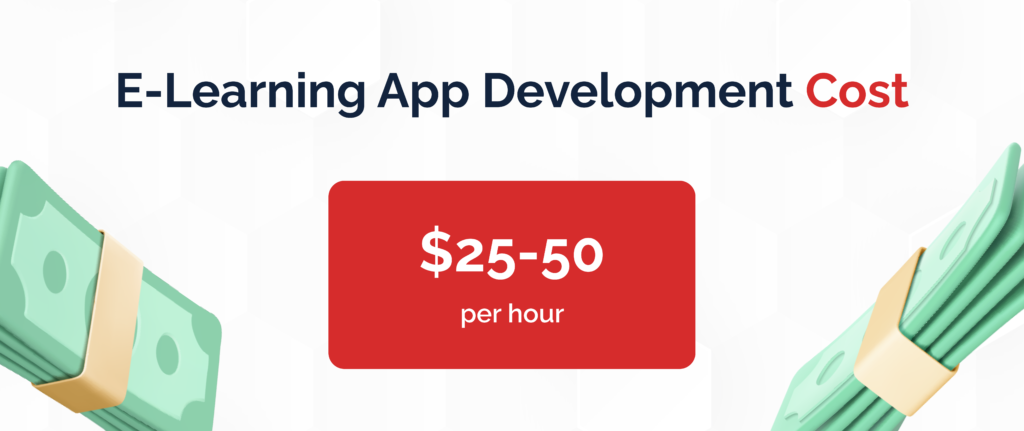
Now that we know how to make an e-learning app, it’s time to look at costs:
The cost of an e-learning MVP
An average MVP costs between 14000 and 20000 dollars if you’re after a complex project. Simpler frameworks require fewer funds (from 5000 to 10000 dollars).
Full-scale product cost
Full-scale products will cost you twice the MVP price. After all, developers must spend time removing bugs and improving the UI. One should expect expenditures between 28000 and 40000 dollars.
Promotion on social media
Everything depends on the ever-changing advertisement agencies’ rates. Granted that you have an in-house social media promotion team, ads will cost 40 dollars per 1000 clicks. To reach one million views, firms must spend at least 40000 dollars.
Developers’ rate
The developers’ rate depends on the region of operations. A yearly developer salary is 110000 U.S. dollars in the United States. Outsourcing is cheaper: Ukrainian developers get 24000 to 36000 dollars. The rate for our company, Keenethics, is 25 to 50 dollars per hour.
Conclusion
To summarize, developing e-learning apps isn’t as difficult as it seems. For a company with sufficient resources, it’s also cheap. What’s necessary for success is a good idea capable of capturing a niche. E-learning apps must deliver a unique and structured experience to the customers.
FAQs
What is an application for e-learning?
An e-learning application, often a mobile learning application, is a type of application designed for online education. It utilizes various features such as augmented reality, video lessons, quizzes, and customizable user accounts to provide an interactive and flexible learning experience. E-learning apps differ from traditional learning methods, offering a dynamic platform that accommodates diverse training levels and aligns with evolving educational trends. E-learning App Development plays a crucial role in creating these apps, ensuring they’re equipped with the latest technologies to enhance the overall learning journey.
What benefits do e-learning platforms provide?
E-learning platforms offer numerous advantages, including accessibility, flexibility, and personalized training. These platforms, developed through E-learning App Development, enable learners to access content anytime, anywhere. With features like quizzes and video lessons, users can engage in interactive training, fostering a deeper understanding. E-learning promotes a tailored learning experience, accommodating various levels of expertise. Additionally, the incorporation of augmented reality enhances the overall training environment. E-learning platforms revolutionize traditional education, aligning with contemporary trends and facilitating efficient and effective online education.
Who May Benefit from Custom E-Learning Outsourcing?
Companies that don’t have a coding department. They can work with partners to develop something high-quality.
What are the monetization paths?
You can insert ads into your app via the basic frameworks of Google and Apple. It’s also possible to have subscription models or one-time purchase approaches.
What does e-learning stand for?
E-learning is about facilitating the learning process through information technology. For instance, computer-based card learning in Anki is an example of e-learning.
Our company offers help with such applications. Address us, and we’ll provide high-quality assistance!

